Sarcos Demonstrates Powered Exosuit That Gives Workers Super Strength
One year ago, for IEEE Spectrum's special report on the Top Tech for 2019, Sarcos Robotics promised that by the end of the year they'd be ready to ship a powered exoskeleton that would be the future of industrial work. And late last month, Sarcos invited us to Salt Lake City, Utah, to see what that future looks like.
Sarcos has been developing powered exoskeletons and the robotic technologies that make them possible for decades, and the lobby of the company's headquarters is a resting place for concepts and prototype hardware that's been abandoned along the way. But now, Sarcos is ready to unveil the prototype of the Guardian XO, a strength-multiplying exoskeleton that's about to begin shipping.
As our introductory briefing concludes, Sarcos CEO Ben Wolff is visibly excited to be able to show off what they've been working on in their lab. "If you were to ask the question, What does 30 years and $300 million look like," Wolff tells us, "you're going to see it downstairs."
This is what we see downstairs:
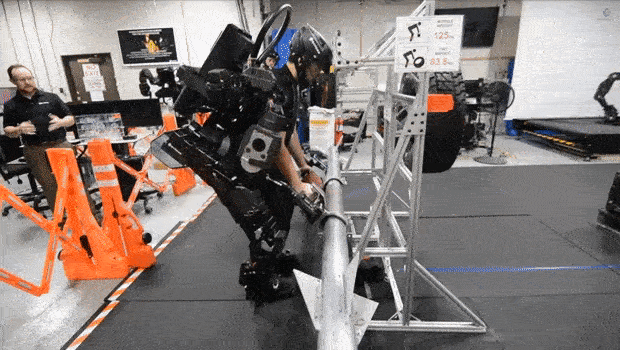 GIF: Evan Ackerman/IEEE Spectrum Guardian XO operator Fletcher Garrison demonstrates the company's exosuit by lifting a 125-pound payload. Sarcos says this task usually requires three people. How the Guardian XO Works
GIF: Evan Ackerman/IEEE Spectrum Guardian XO operator Fletcher Garrison demonstrates the company's exosuit by lifting a 125-pound payload. Sarcos says this task usually requires three people. How the Guardian XO Works The Sarcos Guardian XO is a 24-degrees-of-freedom full-body robotic exoskeleton. While wearing it, a human can lift 200 pounds (90 kilograms) while feeling like they're lifting just 10 lbs (4.5 kg). The Guardian XO is fully electrical and untethered with a runtime of 2 hours, and hot-swappable battery packs can keep it going for a full work day. It takes seconds to put on and take off, and Sarcos says new users can be trained to use the system in minutes. One Guardian XO costs $100,000 per year to rent, and the company will be shipping its first batch of alpha units to customers (including both heavy industry and the U.S. military) in January.
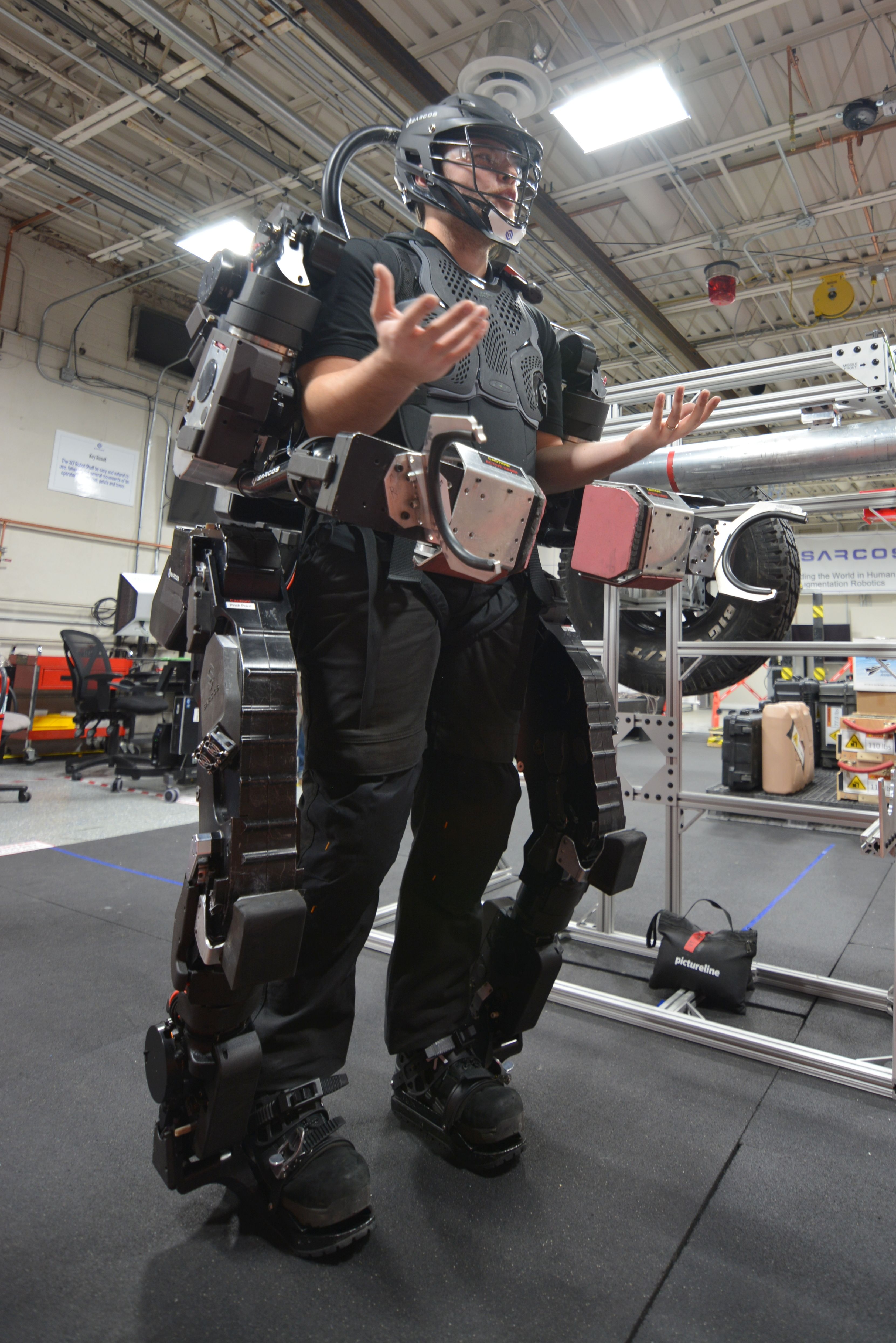 Photo: Evan Ackerman/IEEE Spectrum The prototype that Sarcos demonstrated had all of the functionality of the version that will ship in January, but latter models will include plastic fairings over the suit as well as quick-change end-effectors.
Photo: Evan Ackerman/IEEE Spectrum The prototype that Sarcos demonstrated had all of the functionality of the version that will ship in January, but latter models will include plastic fairings over the suit as well as quick-change end-effectors. In a practical sense, the Guardian XO is a humanoid robot that uses a real human as its command and control system. As companies of all kinds look towards increasing efficiency through automation, Sarcos believes that the most effective solution is a direct combination of humans and machines, enhancing the intelligence and judgement of humans with the strength and endurance of robots. (Investors in the company include Caterpillar, GE Ventures, Microsoft, and Schlumberger.)
The first thing to understand about the Guardian XO is that like a humanoid robot, it's self-supporting. Since it has its own legs and feet, the 150 lb weight of the suit (and whatever it's carrying) bypasses its user and is transferred directly into the ground. You don't strap the robot to you-you strap yourself to the robot, a process that takes less than a minute. So although it looks heavy and bulky (and it is definitely both of those things), at least the weight of the system isn't something that the user experiences directly. You can see how that works by watching Guardian XO operator Fletcher Garrison lifting all kinds of payloads in the video below.
Hands On With the Guardian XOWhen Sarcos reached out and asked if we wanted to come to Salt Lake City to try out the XO, we immediately said yes (disclosure: Sarcos covered our costs to attend a media event last month). But we were disappointed when, in the end, we were only allowed to try out a one-armed version of the exoskeleton. I even offered to sign additional waivers but, alas, the company wouldn't let me into the full suit. So my experience with the exo was pretty limited-a hands-on, literally, of a single XO arm.
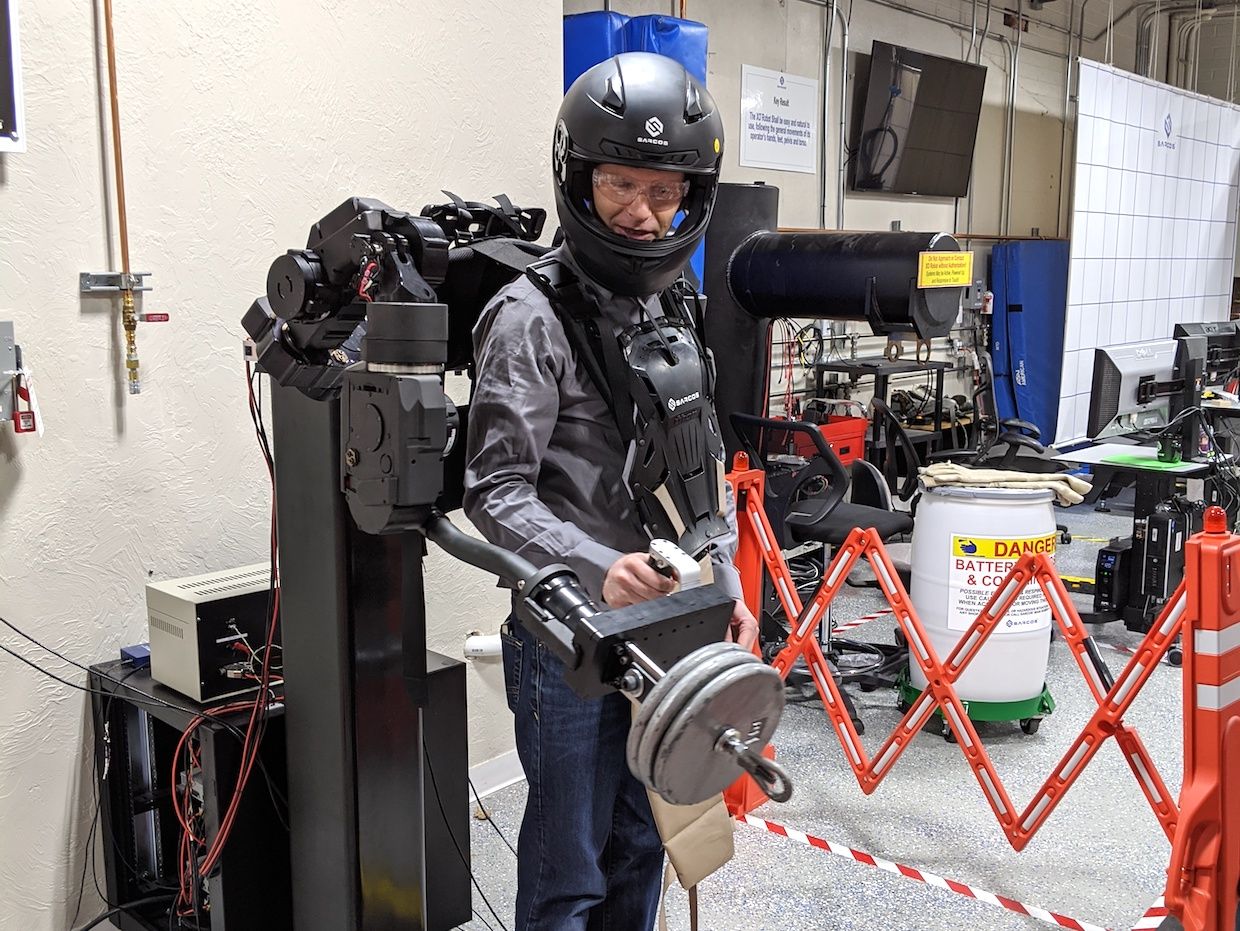 Photo: Evan Ackerman/IEEE Spectrum That's me trying out the one-arm XO system. It's not quite like the full-body suit, but Sarcos still required me to sign a "waiver of liability, assumption of risk, and indemnity agreement."
Photo: Evan Ackerman/IEEE Spectrum That's me trying out the one-arm XO system. It's not quite like the full-body suit, but Sarcos still required me to sign a "waiver of liability, assumption of risk, and indemnity agreement." Still, it was an amazing sensation. The arm I tested, which Sarcos says uses the same control system as the full-body suit, was incredibly easy to operate. In terms of control, all the exo tries to do is get out of the way of your limbs: It uses force sensors to detect every motion that you make, and then moves its own limbs in parallel, smoothly matching your body with its own hardware. If you take a step, it takes a step with you. If you swing your arm back and forth, it swings its arm back and forth in the same way, right next to yours. There's no discernible lag to this process, and it's so intuitive that Sarcos says most people take just a minute or two to get comfortable using the system, and just an hour or two to be comfortable doing work in it.
The Guardian XO can augment the strength of the user all the way up to making a 200-pound load feel like it weighs zero pounds. Typically, this is not how the exoskeleton works, though, since it can be disconcerting to be lifting something heavy and not feel like you're lifting anything at all. It's better to think of the exo as a tool that makes you stronger rather than a tool that makes objects weightless, especially since you still have to deal with inertia. Remember, even if something has no apparent weight (either because you're in space or because you're holding it with a powered exoskeleton), it still has mass, which you have to be aware of when trying to move it or stop it from moving. The amount of help that the exo gives you is easy to adjust; it's got a graphical control panel on the left wrist.
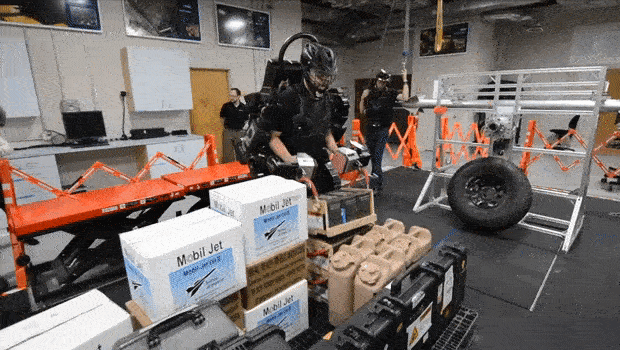 GIF: Evan Ackerman/IEEE Spectrum This ammo crate weighs 110 pounds, but the exoskeleton makes it feel like each arm is lifting just 6 pounds. The Guardian XO is designed for loads of up to 200 lbs. How Safe Is the Exoskeleton?
GIF: Evan Ackerman/IEEE Spectrum This ammo crate weighs 110 pounds, but the exoskeleton makes it feel like each arm is lifting just 6 pounds. The Guardian XO is designed for loads of up to 200 lbs. How Safe Is the Exoskeleton? With a robotic system this powerful (XO has a peak torque of about 4000 inch-pounds, or 450 newton-meters), Sarcos made safety a top priority. For example, to move the exo's arms, your hands need to be holding down triggers. If you let go of the triggers (for whatever reason), the arms will lock in place, which has the added benefit of letting the exo hold stuff up for you while you, say, check your phone. All of the joints are speed limited, meaning that you can't throw a punch with the exo-they told me this during my demo, so of course I tried it, and the joints locked themselves as soon as I exceeded their safety threshold. If the system loses power for any reason, current shunts back through the motors, bringing them down gradually rather than abruptly. And by design the joints are not capable of exceeding a human range of motion, which means that the exoskeleton can't bend or twist in a way that would injure you. Interestingly, the Guardian XO's joint speeds are easily fast enough to allow you to run, although that's been limited for safety reasons as well.
We asked about whether falling down was much of a risk, but it turns out that having a human in the loop for control makes that problem much simpler. Sarcos hasn't had to program the Guardian XO to balance itself, because the human inside does all of that naturally. Having someone try to push you over while you're in the exoskeleton is no different than having someone try to push you over while you're out of it, because you'll keep your own balance in either case. If you do end up falling over, Sarcos claims that the exoskeleton is designed as a roll cage, so odds are you'll be fine, although it's not clear how easy it would be to get out of it afterwards (or get it off of you).
More of a concern is how the XO will operate around other people. While its mass and bulk may not make all that much of a different to the user, it seems like working collaboratively could be a problem, as could working in small spaces or around anything fragile. The suit does have force feedback so that you'll feel if you contact something, but by then it might be too late to prevent an accident.
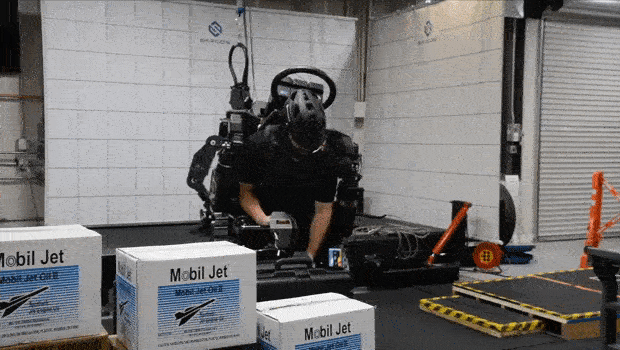 GIF: Evan Ackerman/IEEE Spectrum With a pair of 12 lb 500 watt-hour battery packs, the exoskeleton can operate for over 2 hours during normal use. Energy Efficiency and Reliability
GIF: Evan Ackerman/IEEE Spectrum With a pair of 12 lb 500 watt-hour battery packs, the exoskeleton can operate for over 2 hours during normal use. Energy Efficiency and Reliability Efficiency might not seem like a big deal for an exoskeleton like this, but what Sarcos has managed is very impressive. The Guardian XO uses about 500 watts while fully operational-that is, while carrying 160 lbs and walking at 3 mph. To put that in context, SRI's DURUS robot, which was designed specifically for efficiency (and is significantly smaller and lighter than the Guardian XO), used 350 watts while just walking. "That's really one of our key innovations," says Sarcos COO Chris Beaufait. "There aren't many robots in the world that are as efficient as what we're doing." These innovations come in the form of energy recovery mechanisms, reductions in the number of individual computers on-board, and getting everything as tightly integrated as possible. With a pair of 12 lb 500 watt-hour battery packs, the exoskeleton can operate for over 2 hours during normal use, and Sarcos expects to improve the efficiency from 500 watts to 425 watts or better by January.
Since the Guardian XO is a commercial product, it has to be reliable enough to be a practical tool that's cost effective to use. "The difference between being an R&D shop that can prove a concept versus making a commercially viable product that's robust-it takes an entirely different skill set and mind set," Wolff, the CEO, told us. "That's been a challenge. I think it's the biggest challenge that robotics companies have, and we've put a lot of blood, sweat, and tears into that."
Wolff says that future XO versions (not the alpha model that will ship in January) will be able to walk outdoors over challenging terrain, through a foot of mud, and in the rain or snow. It will be able to go up and down stairs, although they're currently working on making sure that this will be safe. The expectation, Wolff tells us, is that there won't be much ongoing service or maintenance required for the exo's customers. We're not sure we share Sarcos' confidence yet-this is a complex system that's going to be used by non-engineers in semi and unstructured environments. A lot of unexpected scenarios can happen, and until they do, we won't know for sure how well the Guardian XO will stand up to real-world use.
Guardian XO ApplicationsThe Guardian XO has been designed to target some specific (but also very common) types of jobs that require humans to repetitively lift heavy things. These jobs are generally not automatable, or at least not automatable in a way that's cost effective-the skill of a human is required. These jobs are also labor intensive, which creates both short term and long term problems for human workers. Short term, acute injuries (like back injuries) lead to lost productivity. Long term, these injuries add up to serious medical problems for workers, many of whom can only function for between five and eight years before their bodies become permanently damaged.
Wolff believes that this is where there's an opportunity for powered exoskeletons. Using the Guardian XO to offload the kinds of tasks that put strain on a worker's body means that humans can work at a job longer without injury. And they can keep working at that same job as they age, since the exoskeleton takes jobs that used to be about strength and instead makes them about skill and experience.
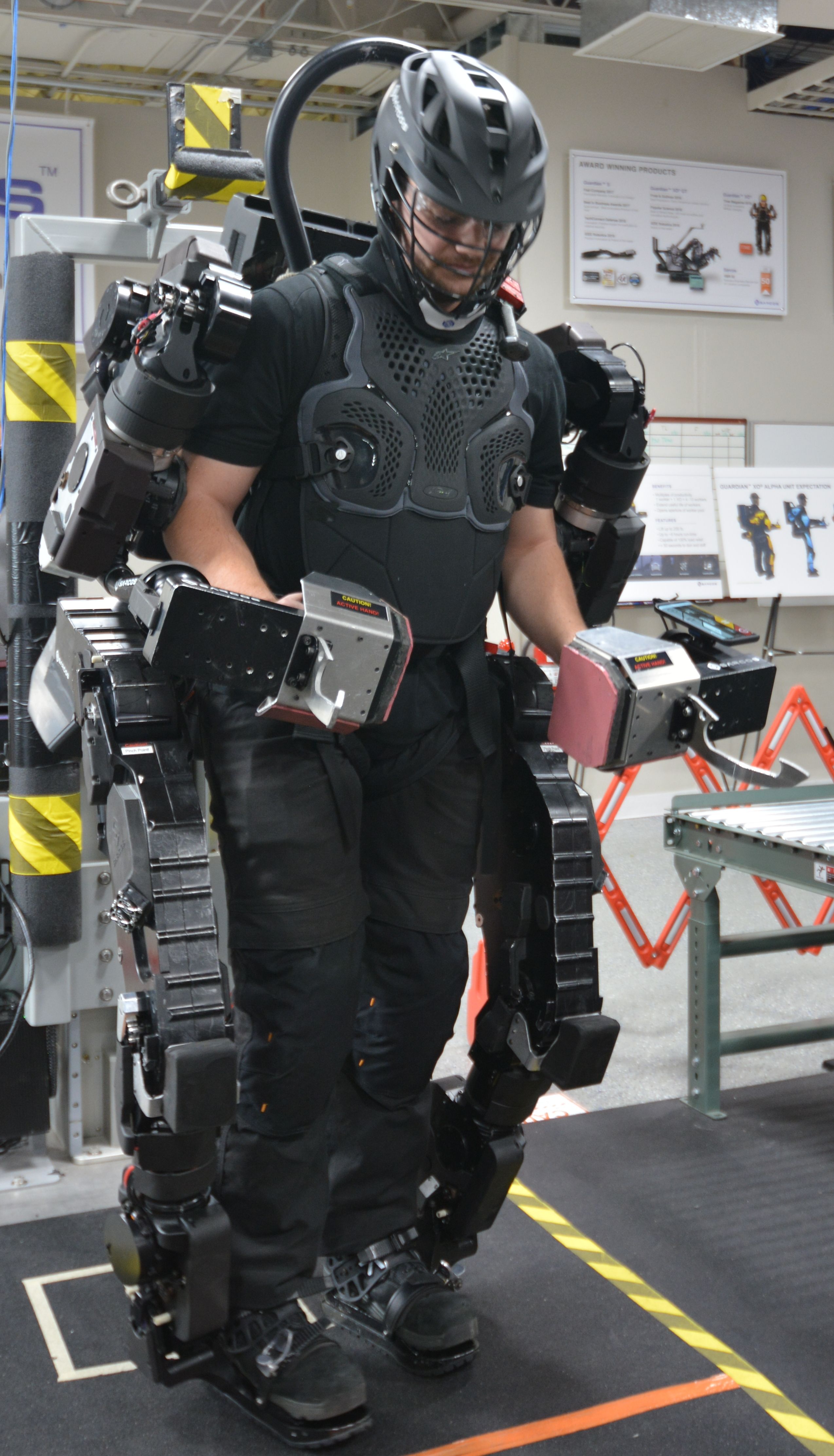 Photo: Evan Ackerman/IEEE Spectrum Sarcos says that one worker in an exoskeleton can handle tasks that would otherwise take between 4 and 10 people.
Photo: Evan Ackerman/IEEE Spectrum Sarcos says that one worker in an exoskeleton can handle tasks that would otherwise take between 4 and 10 people. Of course, the sad fact is that none of this stuff about worker health would matter all that much if companies couldn't be convinced that exoskeletons could also save them money. Fortunately for workers, it's an easy argument to make. Since the Guardian XO can lift 200 pounds, Wolff says that it can improve the productivity of its user by up to an order of magnitude: "Overall, we're seeing across the board improved productivity of somewhere between 4 and 10 times in use cases that we've looked at. So what that means is, one worker in an exoskeleton can do the work of between 4 and 10 employees without any stress or strain on their body."
On the 4x end of the scale, it's just about being able to lift more, and for longer. OSHA recommends a maximum one person load of 51 pounds, a number that gets adjusted downwards if the object has to be lifted repetitively, held for a long time, or moved. The Guardian XO allows a worker to lift four times that, for hours, while walking at up to 3 mph. Things are a little more complicated on the 10x end of the scale, but you can imagine a single 200 pound object that requires an overhead crane plus several people to manage it. It's not just about the extra people-it's also about the extra time and infrastructure required, when a single worker in a Guardian XO could just pick up that same object and move it by themselves.
The obvious question at this point is whether introducing powered exoskeletons is going to put people out of work. Wolff insists that is not the reality of the industry right now, since the real problem is finding qualified workers to hire in the first place. "None of our customers are talking about firing people," Wolff says. "All of them are talking about simply not being able to produce enough of their products or services to keep their customers happy." It should keep workers happy as well. Wolff tells us that they've had "enthusiastic responses" from workers who've tried the Guardian XO out, with their only concern being whether the exoskeleton can be adjusted to fit folks of different shapes and sizes. While initial units will be adjustable for people ranging in height from 5'4" to 6', by next year, Sarcos promises that they'll be adjustable enough to cover 90 percent of the American workforce.
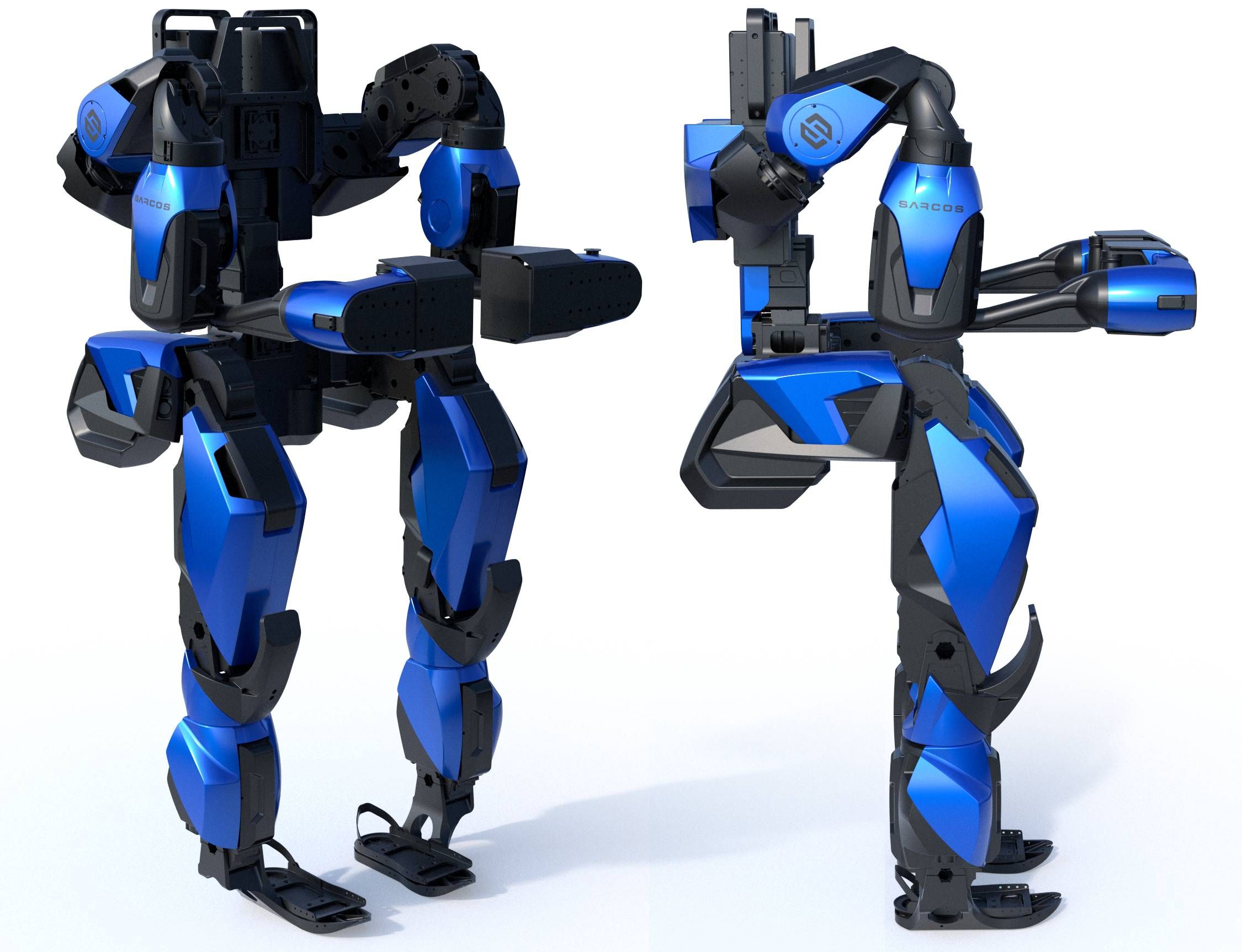 Image: Sarcos A rendering of how the Guardian XO will look with fairings applied. Cost and Availability
Image: Sarcos A rendering of how the Guardian XO will look with fairings applied. Cost and Availability "We could not have made this an economically viable product three years ago," Wolff says. "The size, power, weight, and cost of all of the components that we use-all of that has now gotten to a point where this is commercially feasible." What that means, for Sarcos and the companies that they're partnering with, is that each exoskeleton costs about $100,000 per year. The alpha units will be going to companies that can afford at least 10 of them at once, and Sarcos will send a dedicated engineer along with each batch. The Guardian XO is being sold as a service rather than a product-at least for now, it's more of a rental with dedicated customer support. "The goal is this has to be stupid simple to manage and use," says Wolff, adding that Sarcos expects to learn a lot over the next few months once the exoskeletons start being deployed. Commercial versions should ship later in 2020.
I made sure to ask Wolff when I might be able to rent one of these things from my local hardware store for the next time I have to move, but disappointingly, he doesn't see that happening anytime soon. Sarcos still has a lot to learn about how to make a business out of exoskeletons, and they'd rather keep expectations realistic than promise anyone an Iron Man suit. It's too late for me, though-I've seen what the Guardian XO can do. And I want one.
[ Sarcos ]